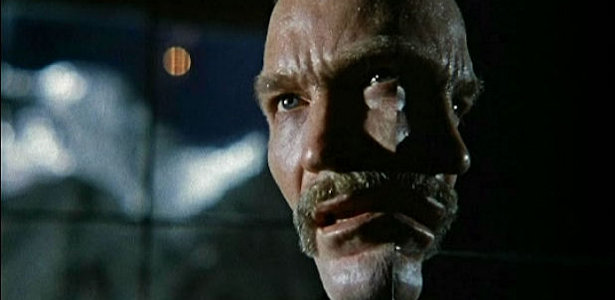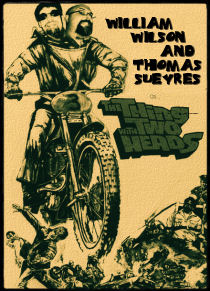We’ve got one heck of a birthday today, but it is not of the box office variety because today’s celebrant didn’t grace the silver screen in the United States. Instead, our subject debuted on the ol’ boob tube. (Oh, crap, is Google going to bust us now for using the word “boob” on here?) Amazingly, this low budget movie of the week soon burst into the national consciousness and scarred the minds of a full generation of kids (mine included) unlike anything seen on TV before. Yes, today marks the 40th anniversary of the first airing of TRILOGY OF TERROR.
TRILOGY was the brainchild of TV writer-producer-director Dan Curtis, who saw success right out of the gate when his horror-theme soap opera DARK SHADOWS debuted on ABC in 1966. That show had an amazing five year run (1966-1971) and produced two theatrical films – HOUSE OF DARK SHADOWS (1970) and NIGHT OF DARK SHADOWS (1971). Knowing horror product was viable on the small screen Curtis started pumping out more horror-themed productions between 1972 and 1974 via his Dan Curtis Productions. This gave us two Kolchak movies (THE NIGHT STALKER [1973] and THE NIGHT STRANGLER [1973]), BRAM STOKER’S DRACULA (1974), and SCREAM OF THE WOLF (1974). These productions are particularly important as they marked the first collaborations between Curtis and screenwriter-author Richard Matheson.
Seemingly a workaholic, Curtis moved into 1974 with the busiest schedule of productions in his career. Rather that bore you with a long paragraph, it might be easier to break down his activity that year month-by-month:
January 1974 – Curtis is in Sacramento, California filming the television pilot MELVIN PURVIS G-MAN (co-written by John Milius and William F. Nolan); Curtis signs on to produce two entries in ABC’s THE WIDE WORLD OF MYSTERY.
February 1974 – Dan Curtis Productions announced two new features for TV: the crime-thriller A BREAK IN THE ICE and the horror series THE NIGHT KILLERS; Curtis also files an antitrust lawsuit against ABC and Worldvision regarding DARK SHADOWS.
March 1974 – Curtis proposes a half-hour “gothic horror” (according to Variety) series called DEAD OF NIGHT for ABC daytime television. Lawsuit one month, TV pitch the next!
April 9, 1974 – MELVIN PURVIS G-MAN debuts on ABC.
May 1974 – A BREAK IN THE ICE announces Lee J. Cobb in the lead role; KOLCHAK TV series gets greenlighted but without Curtis’ involvement.
June 1974 – A BREAK IN THE ICE films.
November 6, 1974 – A BREAK IN THE ICE debuts on ABC with the new title THE GREAT ICE RIP-OFF.
November 21, 1974 – Curtis begins prepping a new film from a script by THE NIGHT KILLERS writers, Richard Matheson and William F. Nolan. The title? TRILOGY OF TERROR.
December 3, 1974 – Variety announces that Karen Black has signed on to play several roles in the newly anointed TRILOGY OF TERROR.
December 1974/January 1975 – TRILOGY OF TERROR films at 20th Century Fox studios.
March 4, 1975 – TRILOGY OF TERROR debuts as ABC’s Tuesday Movie of the Week in an 8:30-10 pm timeslot. Curtis has little chance to celebrate as he is already off filming a PURVIS sequel, THE KANAS CITY MASSACRE (1975).
To say that TRILOGY made an impact would be an understatement. More specifically, it was the third and final segment (“Amelia”) that left such an indelible impression on the nation. Yes, the one with the Zuni warrior fetish doll chasing a terrified Karen Black all over her apartment. Adapted from Matheson’s own short story “Prey,” this segment made such an impression on viewing audiences that most folks only remember that section from the film. Speaking to Fangoria in 1996, co-writer William F. Nolan stated that people were often hard-pressed to even recall the films other two segments. While gathering ratings info from 1975 is virtually impossible, it is probably a safe bet that the movie did well and was the talk around the cooler water coolers the next day.
To showcase the anthology’s popularity, when ABC decided to try to beef up their poor Wednesday night ratings with “Movie of the Week” showcases, Variety reported that they kicked off the effort on September 10, 1975 with a re-airing of TRILOGY OF TERROR. Spend a few minutes on Google and you’ll find plenty of “I remember when that debuted…” and “the most terrifying thing of my childhood” posts. I was just four months old in March 1975, so I wasn’t around watching to have my synapses singed at that time. I eventually caught TRILOGY on VHS in the early 1980s and I’ll be damned if it didn’t scare the hell out of me. The razor-sharp teeth on that doll (in conjunction with the snapping dolls from BARBARELLA [1968]) definitely had me steering clear of my sister’s collection with great fear.
Curtis had created the ultimate killer doll template which would be followed for decades to come. The film – more succinctly, that damn doll – had such staying power that Curtis felt the need to return to it two decades later. He initially announced a theatrical remake, TRILOGY OF TERROR: THE MOVIE, in Variety in October 1992. While that version never got off the ground, he eventually did get TRILOGY OF TERROR II (1996) going a few years later. Appropriately, it was again a TV movie. Reuniting with Matheson and Nolan, Curtis brought forth a new anthology for modern audiences. Naturally, the Zuni fetish doll returned to terrorize new multi-lead Lysette Anthony. With a perfect sense of timing, the new TRILOGY debuted on the USA Network on October 30, 1996 to terrorize an entirely new generation (who, no doubt, probably can’t name the other two segments in this version either). So happy fortieth birthday to the Zuni fetish doll, who doesn’t look a day over thirty!
TRILOGY was the brainchild of TV writer-producer-director Dan Curtis, who saw success right out of the gate when his horror-theme soap opera DARK SHADOWS debuted on ABC in 1966. That show had an amazing five year run (1966-1971) and produced two theatrical films – HOUSE OF DARK SHADOWS (1970) and NIGHT OF DARK SHADOWS (1971). Knowing horror product was viable on the small screen Curtis started pumping out more horror-themed productions between 1972 and 1974 via his Dan Curtis Productions. This gave us two Kolchak movies (THE NIGHT STALKER [1973] and THE NIGHT STRANGLER [1973]), BRAM STOKER’S DRACULA (1974), and SCREAM OF THE WOLF (1974). These productions are particularly important as they marked the first collaborations between Curtis and screenwriter-author Richard Matheson.
January 1974 – Curtis is in Sacramento, California filming the television pilot MELVIN PURVIS G-MAN (co-written by John Milius and William F. Nolan); Curtis signs on to produce two entries in ABC’s THE WIDE WORLD OF MYSTERY.
February 1974 – Dan Curtis Productions announced two new features for TV: the crime-thriller A BREAK IN THE ICE and the horror series THE NIGHT KILLERS; Curtis also files an antitrust lawsuit against ABC and Worldvision regarding DARK SHADOWS.
March 1974 – Curtis proposes a half-hour “gothic horror” (according to Variety) series called DEAD OF NIGHT for ABC daytime television. Lawsuit one month, TV pitch the next!
April 9, 1974 – MELVIN PURVIS G-MAN debuts on ABC.
May 1974 – A BREAK IN THE ICE announces Lee J. Cobb in the lead role; KOLCHAK TV series gets greenlighted but without Curtis’ involvement.
June 1974 – A BREAK IN THE ICE films.
November 6, 1974 – A BREAK IN THE ICE debuts on ABC with the new title THE GREAT ICE RIP-OFF.
November 21, 1974 – Curtis begins prepping a new film from a script by THE NIGHT KILLERS writers, Richard Matheson and William F. Nolan. The title? TRILOGY OF TERROR.
December 3, 1974 – Variety announces that Karen Black has signed on to play several roles in the newly anointed TRILOGY OF TERROR.
December 1974/January 1975 – TRILOGY OF TERROR films at 20th Century Fox studios.
March 4, 1975 – TRILOGY OF TERROR debuts as ABC’s Tuesday Movie of the Week in an 8:30-10 pm timeslot. Curtis has little chance to celebrate as he is already off filming a PURVIS sequel, THE KANAS CITY MASSACRE (1975).
To say that TRILOGY made an impact would be an understatement. More specifically, it was the third and final segment (“Amelia”) that left such an indelible impression on the nation. Yes, the one with the Zuni warrior fetish doll chasing a terrified Karen Black all over her apartment. Adapted from Matheson’s own short story “Prey,” this segment made such an impression on viewing audiences that most folks only remember that section from the film. Speaking to Fangoria in 1996, co-writer William F. Nolan stated that people were often hard-pressed to even recall the films other two segments. While gathering ratings info from 1975 is virtually impossible, it is probably a safe bet that the movie did well and was the talk around the cooler water coolers the next day.
A look at TRILOGY OF TERROR's competition:
To showcase the anthology’s popularity, when ABC decided to try to beef up their poor Wednesday night ratings with “Movie of the Week” showcases, Variety reported that they kicked off the effort on September 10, 1975 with a re-airing of TRILOGY OF TERROR. Spend a few minutes on Google and you’ll find plenty of “I remember when that debuted…” and “the most terrifying thing of my childhood” posts. I was just four months old in March 1975, so I wasn’t around watching to have my synapses singed at that time. I eventually caught TRILOGY on VHS in the early 1980s and I’ll be damned if it didn’t scare the hell out of me. The razor-sharp teeth on that doll (in conjunction with the snapping dolls from BARBARELLA [1968]) definitely had me steering clear of my sister’s collection with great fear.
TV Guide article on TRILOGY OF TERROR
(click to enlarge):
Curtis had created the ultimate killer doll template which would be followed for decades to come. The film – more succinctly, that damn doll – had such staying power that Curtis felt the need to return to it two decades later. He initially announced a theatrical remake, TRILOGY OF TERROR: THE MOVIE, in Variety in October 1992. While that version never got off the ground, he eventually did get TRILOGY OF TERROR II (1996) going a few years later. Appropriately, it was again a TV movie. Reuniting with Matheson and Nolan, Curtis brought forth a new anthology for modern audiences. Naturally, the Zuni fetish doll returned to terrorize new multi-lead Lysette Anthony. With a perfect sense of timing, the new TRILOGY debuted on the USA Network on October 30, 1996 to terrorize an entirely new generation (who, no doubt, probably can’t name the other two segments in this version either). So happy fortieth birthday to the Zuni fetish doll, who doesn’t look a day over thirty!





































































